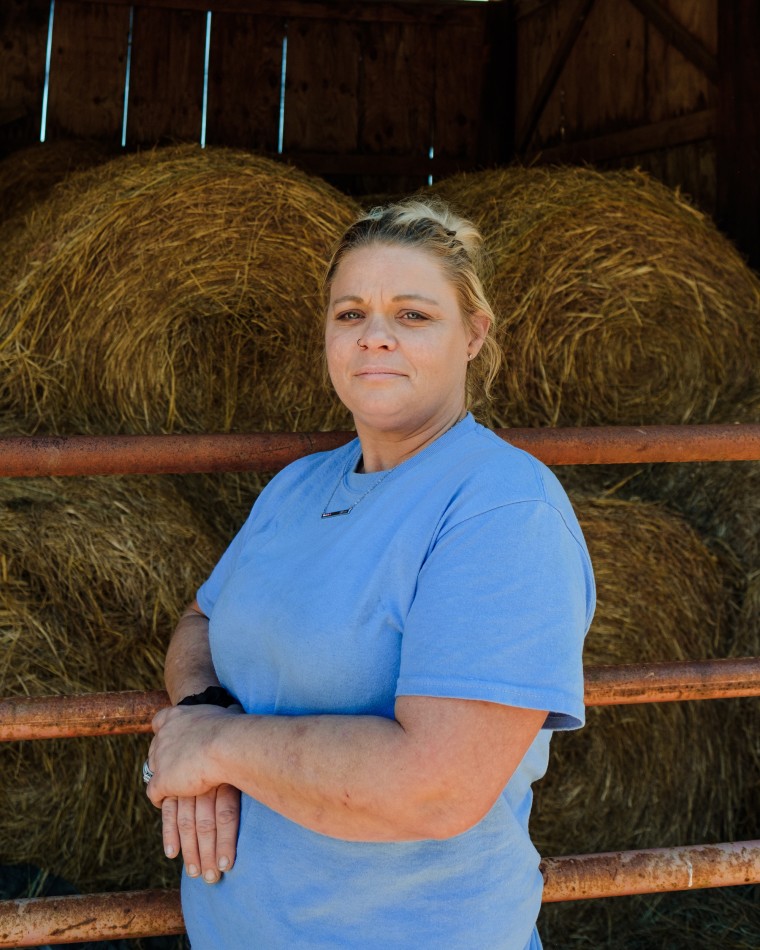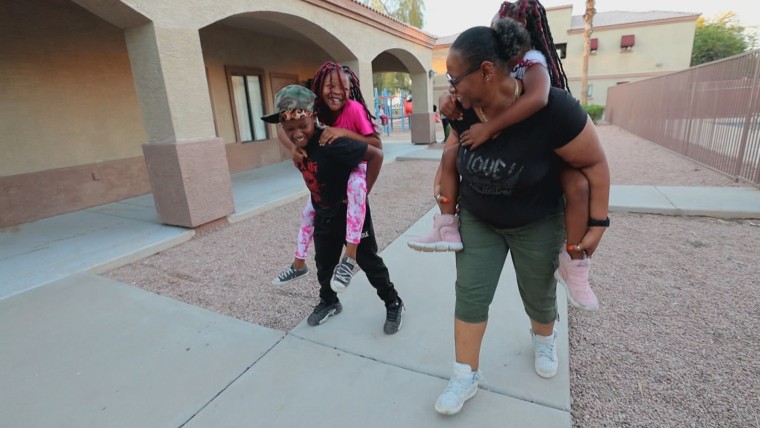[ad_1]
This article was published in partnership with ProPublica, a nonprofit newsroom that investigates abuses of power. Sign up to receive ProPublica’s biggest stories as soon as they’re published.
CHARLESTON, W.Va. — In the months after a West Virginia court permanently took away their right to parent their daughters this past April, Jackie Snodgrass and her husband were left in a quiet house. The kids’ rooms remained untouched. The same dolls and stuffed animals were arranged on their younger daughter’s bed. The same clothes in the closets, becoming outgrown. The same photos on the walls, outdated.
The court had denied a final visit — despite the children continually saying they missed their mother — so the parents never got to say goodbye to them in person. Snodgrass worried about them constantly, especially her older daughter, who has diabetes. An app pinged her intermittently with updates on her child’s blood sugar. Occasionally, it would dip too low or spike too high.
“What if something happens to her?” Snodgrass said. “And if it does, I’m not going to be allowed to be there.”
Once considered a last resort reserved for parents who abandon their children, the involuntary and permanent termination of parental rights now hangs over every mother and father accused of any form of abuse or neglect — including allegations of nonviolent behavior like drug use or truancy, the two central parenting issues in the Snodgrasses’ case. Known in the legal world as the “death penalty” of child welfare, it can happen in a matter of months.
No state terminates parental rights more frequently or faster than West Virginia, according to a ProPublica and NBC News analysis. One in 50 children here experienced the severing of their relationships with both of their parents from 2015 to 2019, the last full year of federal child welfare data available before the pandemic. For most of them, it occurred within 11 months of being removed from their home for the first time.
In the Snodgrasses’ case, it took only five months.
Nationally, the parents of about 327,000 children lost their rights from 2015 to 2019, the analysis found. In one-fifth of those cases, it happened in less than a year.
Over the past 25 years, courts and child protective services agencies have increasingly turned to this ultimate consequence, partly in response to Clinton-era federal policies that support faster adoptions. According to a recent study, the risk that a child will experience the loss of their legal relationship with their parents roughly doubled from 2000 to 2016. One in 100 U.S. children — disproportionately Black and Native American — experience termination through the child welfare system before they turn 18, the study found.
Most of those families became entangled in the system because of allegations of neglect, a broad category closely linked to poverty and substance use. Just 15% of children whose parents’ rights were severed around the country from 2015 to 2019 had been removed from their homes because of concerns about physical or sexual abuse, according to the ProPublica and NBC News analysis. (The reasons ultimately cited for the terminations themselves weren’t provided in the data.)
“None of us believes banishing a child from a family of origin is a perfectly fine result,” said Marty Guggenheim, a retired New York University law professor and child welfare expert who has argued termination cases before the Supreme Court. “But that’s where we are today. We are off of our moral compass.”
The hurry to end families can be traced to the 1997 Adoption and Safe Families Act, passed with bipartisan support in Congress and signed by President Bill Clinton.
In a tough-on-crime era, the new law was supposed to keep fragile, abused children from languishing for too long in foster care. It created a rigid timeline — a ticking clock — for every child who entered state custody after having been removed from home because of an allegation of child maltreatment. After 15 months, barring specific exemptions, state and local agencies were required to file for termination of the birth parents’ rights or face losing federal funding. And states that increased adoptions were rewarded with bonuses for every additional child they placed.
Despite the law’s goal of getting more kids adopted, tens of thousands of such children have remained in foster care for months or years after being cut off from their parents. They are known as “legal orphans,” with no birth families anymore but no adoptive ones, either.
And research shows that many children who experience termination of their parents’ rights will suffer what is known as ambiguous loss, similar to grieving after a death but without the closure of knowing a loved one is gone forever.
How America’s child welfare dragnet ensnares struggling families
To understand the impact of the child welfare system’s most extreme outcome, ProPublica and NBC News surveyed hundreds of families who experienced termination of parental rights and interviewed dozens of parents, children, caretakers, caseworkers and attorneys. Those we spoke to described a confusing legal system that at times seemed stacked against birth families trying to reunite and inured to the pain of long-term family separation.
“There was all this lost time when me and my dad had wanted to talk to each other but were being prevented by the state government,” said Reed Ridens, a graduate student in Albuquerque, New Mexico, who spent years in foster care as a legal orphan. “There was a lot of damage and a lot of repair that needed to be done between us, and a lot that had been taken away.”
Some of the 1997 law’s original supporters — and even some top child welfare officials — now warn that the timeline Congress prescribed is too rigid and that some states may have taken the reforms too far.
Maureen Flatley, a child welfare consultant who helped craft the law, said she now believes it urgently needs to be revamped, including the prescribed timeline for terminating parental rights. “We can’t pretend anymore that adoption is just some magic panacea,” she said in an interview.
The federal government also has voiced concerns about focusing too narrowly on termination time frames. In the final days of the Trump administration, the Department of Health and Human Services’ Administration for Children and Families issued a memo warning states against rushing to end rights.
Jerry Milner, a top official at the agency under President Donald Trump, said the Clinton-era law should be overhauled or repealed. Its timeline was the product of political negotiation, he said, not scientific research on how long parents should be given for recovery or redemption before they lose their rights to their children. “But it’s hanging over parents’ heads like a death sentence,” he said.
Yet the Biden administration has continued to defend the law. The statute allows states to make exceptions to the timeline if they believe termination would not be “in the best interest of the child” or if the state has failed to provide adequate reunification services, an ACF spokesperson said in response to written questions. Decisions are to be made on a case-by-case basis, the agency added.
And recent attempts by Congress to revise the timeline have failed to gain much traction.
Rep. Sheila Cherfilus-McCormick, D-Fla., believes it’s imperative for lawmakers to try once more: She plans to introduce a child welfare bill in the next Congress to allow states to extend the timeline for termination to 24 months, among other changes.
“The harsh timeline doesn’t allow people to be rehabilitated or give them a chance to be reunited with their children,” she said.
Five months to end a family
Jackie Snodgrass and her husband, Wes, attracted the attention of West Virginia’s Department of Health and Human Resources in February 2021 because their girls had missed too many days of school. It was a problem that the family and the child protective services agency had tussled over for years, according to court documents Snodgrass provided to ProPublica and NBC News, but it came to a head when their absences piled up amid virtual schooling during the pandemic. Both parents were placed under court-ordered supervision.
The family moved from their tiny town of 1,400 to Wes Snodgrass’ mother’s home in the capital city, Charleston, to be closer to school for the girls, whose attendance was improving. They started a tree-trimming business and were making ends meet.

By October 2021, Jackie Snodgrass was busy planning her older daughter’s dream 16th birthday party — with pink decorations and a DJ, like on MTV.
“I like their birthdays better than Christmas, because it’s just their day,” she said of her children.
But the stress of the move and the truancy case had taken a toll. Snodgrass’ husband said he had used methamphetamine during that time, and in November, on an impulse, she tried it too. When the court overseeing their case started mandating drug screens, both parents failed.
The child welfare agency’s response was immediate: Like many states, West Virginia considers failed drug tests to be proof that a child is in danger, which can lead to the child’s removal. Snodgrass said a caseworker told her and her husband over the phone that they had to immediately pack up and leave the children with her husband’s mother.
After just five months and a few hearings, as the Snodgrasses struggled to comply with court orders, the judge ruled that they were unfit to raise their girls ever again.
They haven’t seen them in person for over a year.
Jackie Snodgrass’ parents now have custody of the children and plan to adopt them. Her mother said the girls have taken the separation hard, acting out and asking why they can’t see their mom and dad. Visiting is prohibited even though they live 5 miles apart.
[ad_2]
Source link

